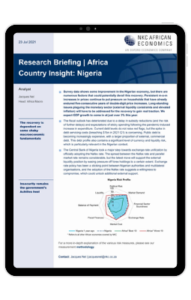Africa | Country Insight: Nigeria

Progress in passing the Petroleum Industry Bill (PIB) and official adoption of the Nafex rate are two significant policy steps in the rights direction. However, with elevated price inflation and just 30.6 million Nigerians out of a population of nearly 210 million considered fully employed, households are under severe strain. Long-standing issues plaguing the monetary sector (external liquidity constraints and elevated inflation) will have to be addressed for the recovery to gain real traction.
What you will learn:
- A tense political environment has encouraged authorities to delay the suspension of subsidies, but fiscal pressures and the regulatory requirements stemming from the PIB could force the government to scrap this form of financial support.
- Public debt is becoming increasingly expensive, with a larger proportion of external, commercial debt. This debt profile also contains a significant level of currency and liquidity risk, which is particularly relevant in the Nigerian context.
- Lagos is by far the largest consumer market in West Africa, with spending totalling an estimated N13.2trn in 2020. Looking ahead, we expect the strongest growth in consumer spending to take place in Abuja and the smaller markets of Port Harcourt and Onitsha.
Tags:
Related Services

Post
UK: Supply constraints are probably less prominent in the south
The extent to which UK employers can respond to likely 2024 interest rate cuts with increased output, rather than rises in prices and wages, will partly reflect the extent of spare capacity. This will inevitably vary by region. Evidence on this is imperfect, but in terms of capital assets (including intangibles) and labour availability, southern regions appear to be in a stronger position than those in the UK's traditional industrial heartland.
Find Out More
Post
Global Private equity real estate fund maturities spur asset sales
We expect the significant increases in fund maturities, spurred by capital raised over the past decade, to exert upward pressure on the rate of asset disposals as the funds approach the end of their lifecycles.
Find Out More